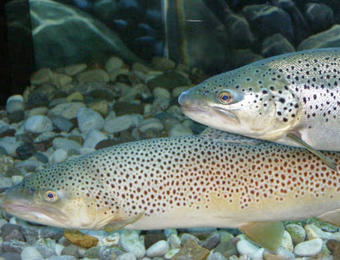Brown trout limit brook trout access to warmer stream stretches. Photo USGS.
A new U.S. Geological Survey study performed at an experimental stream laboratory in Kearneysville, WV, shows non-native brown trout can place a burden on native brook trout under the increased water temperatures climate change can cause.
It is one of the first experimental studies linking climate change and invasive species biology.
The USGS found that non-native browns limited the ability of brook trout to utilize warmer stream temperatures. In contrast, removal of non-native brown trout expanded the brook trout’s reach into warmer waters.
Brook trout are threatened by climate change because of their requirement for cold stream temperatures. “We know streams are warming due to climate change and non-native species are becoming increasingly abundant in many places,” commented Nathaniel Hitt, a USGS research fish biologist and lead author of the study. “Our research indicates that reducing brown trout numbers can benefit native brook trout where the species co-occur,” Hitt said. “Moreover, brown trout management could help brook trout be more resilient to anticipated effects of climate change.”
A more detailed description of the study can be found here.
— Jeff Witten, chair, Ozark Council, Missouri



